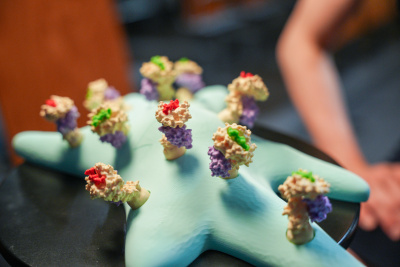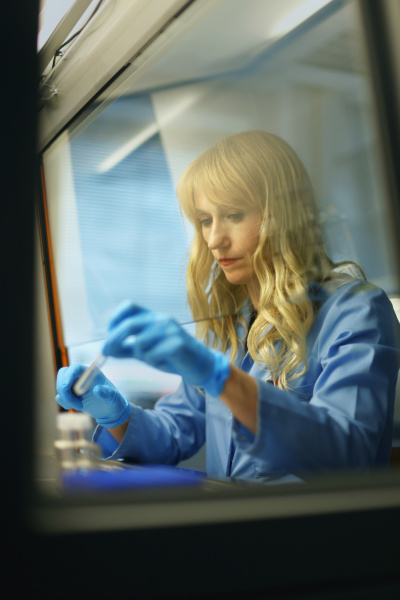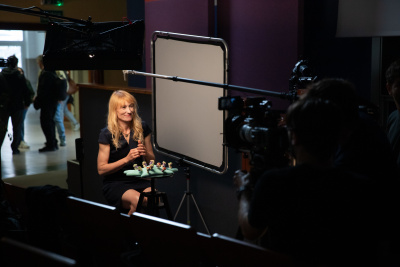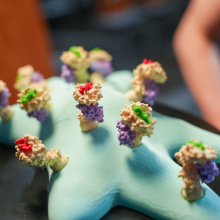International Centre for Cancer Vaccine Science UG, with its CANVAS project, was selected to be a part of the Europe-wide campaign Science4EU that promotes European research achievements and the EU’s actions in support of them. The CANVAS project aims to foster a better understanding of in vitro and animal models in designing the therapy against non-small cell lung cancer, which is the most widespread type of lung cancer in the world. The project was fully funded through the Horizon Europe programme.

ICCVS team; photo © European Union 2025
The key objective of the project was to understand how lung cancer models work in vitro and in vivo to map out suitable therapy with minimum side effects. The research part of the project ends in September 2025 – results will be published in the upcoming months, but as we learned from the team members, they are promising.

Cancer 3D model; photo © European Union 2025
‘The most important outcome, I believe, is that now we understand better what we can learn from cancer models to treat cancer in humans,’ said Prof. Natalia Marek-Trzonkowska, the director of ICCVS UG and coordinator of the project. ‘Many studies of cancer have been done in vitro and in animals, and they were successful, but when they were transferred to humans, they failed. And that's why we designed this project. The CANVAS project enabled us to discover cancer's unique features which are characteristic of the tumour after resection and also persist in cancer models. Cancer models are used by researchers to study the safety and efficacy of anti-cancer approaches. It is extremely important to test the therapy in a model that resembles the real target. Previous studies on T-cell therapies in cancer were less precise, and the researchers were not aware of how much the model differs from the primary tumour and how to use the model in an optimal way to design the therapy. Our project brings new knowledge that is useful for the development of anti-cancer therapies and vaccines.'

Prof. Natalia Marek-Trzonkowska; photo © European Union 2025
Immunotherapy poses a breakthrough in cancer treatment, as it uses self-cells of a patient to target cancer cells specifically.
‘Currently used chemo- and radiotherapy target not only the cancer but are harmful to the healthy tissues, notably cells with fast proliferation rate,’ Professor Marek-Trzonkowska explains. ‘In consequence, they compromise the patients’ immune system making him/her more prone to infections and weaken natural anti-cancer response of the body. Our approach works in opposite way. We mobilize the natural resources of the body. We do not invent the wheel as it already exists. We use the cells which exist in the organism and are able to recognize and kill the cancer. We sort them from the patient blood and expand (multiply them) in the laboratory. Simultaneously, we activate these cells to make them more potent.’
Cancer immunotherapy so far used mostly so-called CAR T-cells, which where genetically modified. The approach ICCVS is working on uses fully natural T-cells that are able of targeting cancer unique antigens not only expressed on the cancer surface but also hidden inside the cancer cells; such antigens are not visible for CAR-T cells.
As Professor Marek Trzonkowska says, ‘Our therapy is a chance for fully selective treatment of the cancer, avoiding side effects. We use natural T-cells, which means that after cancer eradication most of these therapeutic cells will die, but some of them will stay in the body as memory cells. The latest will patrol the organism and fight the cancer again in case of the tumour renewal. Our work will not finish on generating anti-cancer T cells. We are aware that cancer is a tough opponent and will try to suppress the cells that we will use for the therapy. Therefore, simultaneously, we have been working on a strategy of reprogramming the cancer environment, which is hostile to therapeutic cells. We have been constantly learning cancer biology and tumour and immune cell interactions. The better we understand our enemy, the closer we are to defeating it or making it harmless.’

Science4EU - behind the scenes; photo by Bartłomiej Jętczak
The coordinating institution for the project was the University of Gdańsk. The University of Rome Tor Vergata (UNITOV) from Italy and the Alternative Energies and Atomic Energy Commission (CEA) from France were research partners. The University of Rome Tor Vergata brought extended knowledge of animal models to the table. The team from CEA is focused on bioinformatics and big data analysis, so they analyse genomic-transcriptomic data. The ICCVS team is experienced in T-cell-based therapies, as Prof. Natalia Marek-Trzonkowska has previously designed immunotherapy for type-1 diabetes. Joined efforts fostered new approaches to understanding cancer models' role in designing effective therapy.
Bringing together three outstanding European scientific institutions with unique expertise allowed for the synergy of research potentials in line with the objectives of the European Union's science support programmes. ‘Europe wants to maintain its position as a global leader in scientific research. We are turning our ambition into action: the European Commission's proposed EU budget for 2028-2034 allocates €175 billion to the Horizon Europe research and innovation programme, which is twice as much as in the current budgetary perspective,’ says Katarzyna Smyk, Director of the European Commission Representation in Poland.
Phase 1 clinical trial – when the therapy will be used in humans for the first time – is planned within the next two years.
Learn more about this groundbreaking research from Science4EU perspective:
https://research-and-innovation.ec.europa.eu/events/special-features/science4eu/countries/poland_pl
https://research-and-innovation.ec.europa.eu/events/special-features/science4eu_en
| Attachment | Size |
|---|---|
| Przelom w leczeniu raka coraz blizej dzieki polskim badaniom finansowanym przez UE_komunikat prasowy.pdf | 205.36 KB |













